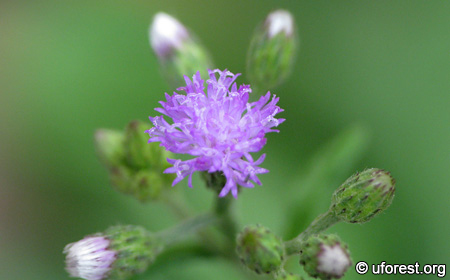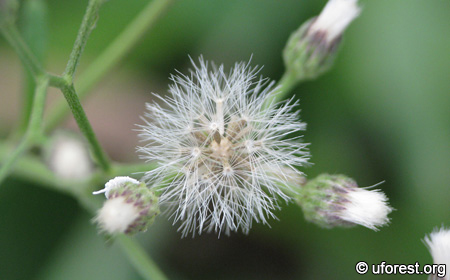Cyanthillium cinereum (L.) H.Rob.
| Etymology | Genus | Dark blue and green, likely referring to the flowers within the genus |
|---|---|---|
| Species | Ash-coloured, probably referring to the fruits | |
| Family | Asteraceae | |
| Synonyms | Conyza cinerea L., Vernonia cinerea (L.) Less. | |
| Common Names | Common Vernonia, Little Ironweed | |
| Status | Native: Least Concern | |
| Form | Herb | |
| Native Distribution | Japan, China, India, Africa, Arabia, Indochina, Malesia, Australia, and the Pacific Islands | |
Diagnostics:
The leaf margins are bluntly serrated and have a distinct petiole flanked by the leaf blades which tapers down towards the stem. The flowers are very distinct with the unopen ones being white, white with purple at the tip, or vice versa. I used to be confused between this and Emilia sonchifolia, but the flower bracts of the latter are much longer and vase-shaped.
Interesting Facts:
This is a very common weed in managed lawns where it flowers frequently. Utomo & van Valkenburg (1999) indicated the Little Ironweed as an Old World species but being naturalised throughout the tropics now. It is known to be used traditionally to treat many aliments like fever, respiratory disorders, skin and gastrointestinal diseases, etc (Globinmed, 2010).
Cyanthillium cinereum on a manicured grassland.

Serrated leaf with the blades running along the petiole.

Purple composite flowers of the Little Ironweed.

Unopened flower heads.

Fruits with tufts of white hair for wind dispersal.
References
Globinmed. (2010) Vernonia cinerea. Global Information Hub on Integrated Science, Institute of Medical Research, Ministry of Health, Malaysia. http://www.globinmed.com. Accessed on 23-Nov-2012.Utomo BI & JLCH van Valkenburg. (1999) Vernonia cinerea (L.) Less. In: de Padua LS, Bunyapraphatsara N & Lemmens RHMJ (Eds.) Plant Resources of South-East Asia No. 12(1): Medicinal and poisonous plants 1. Backhuys Publisher, Leiden, The Netherlands. pp 496-497.
Author: Siyang
Posted: 2012-11-23 / Modified: 2025-10-28
Google Ads